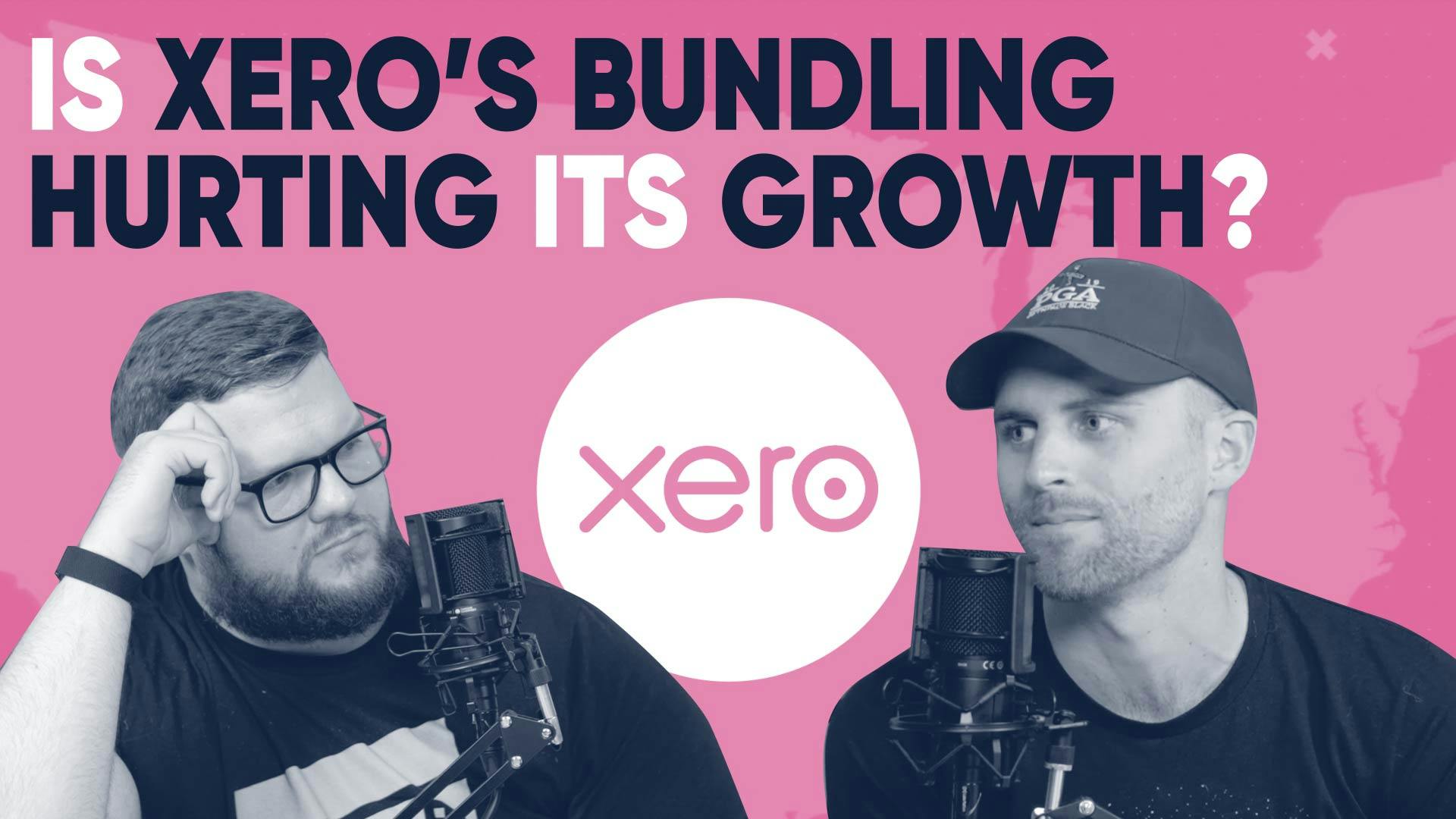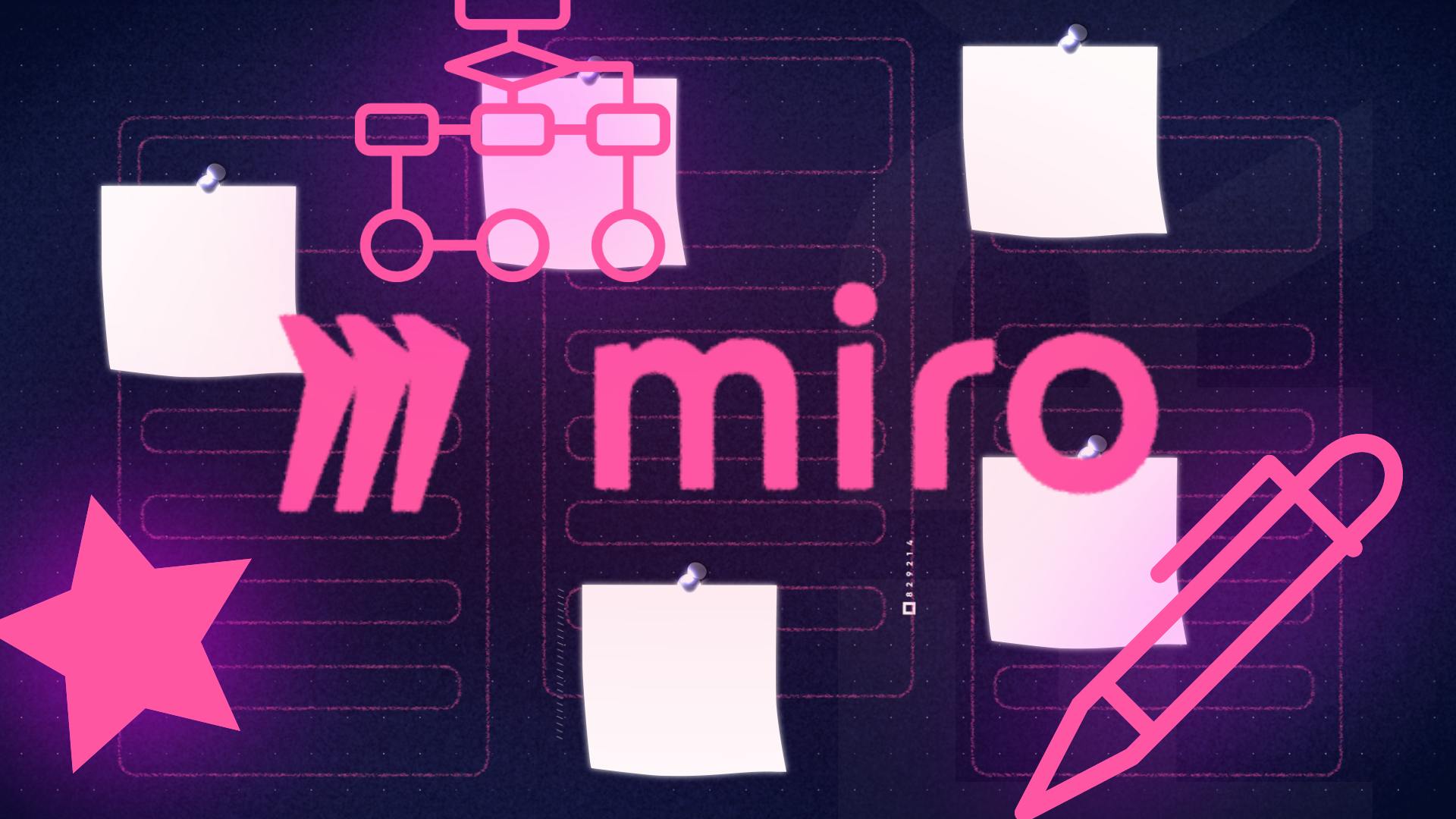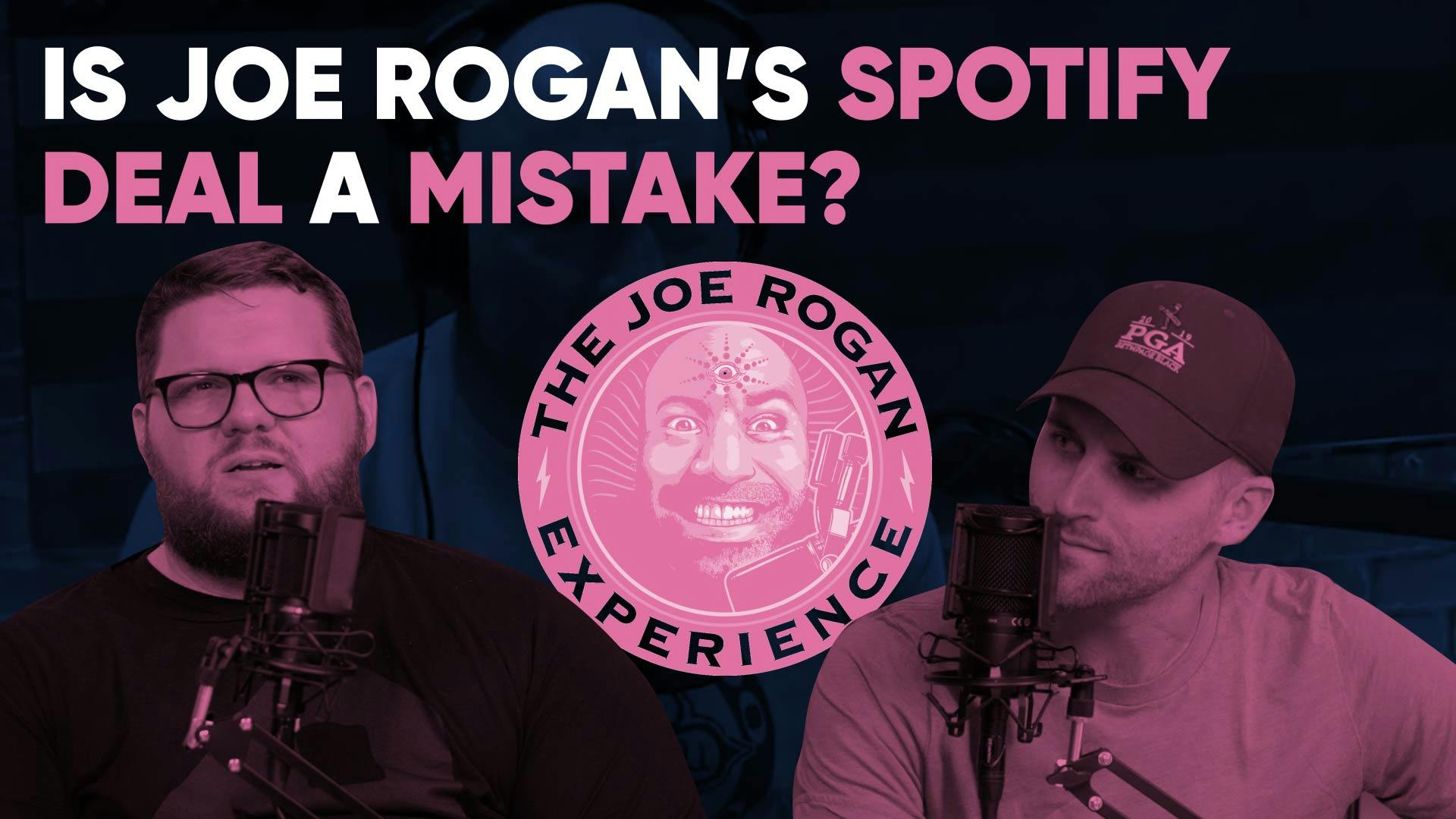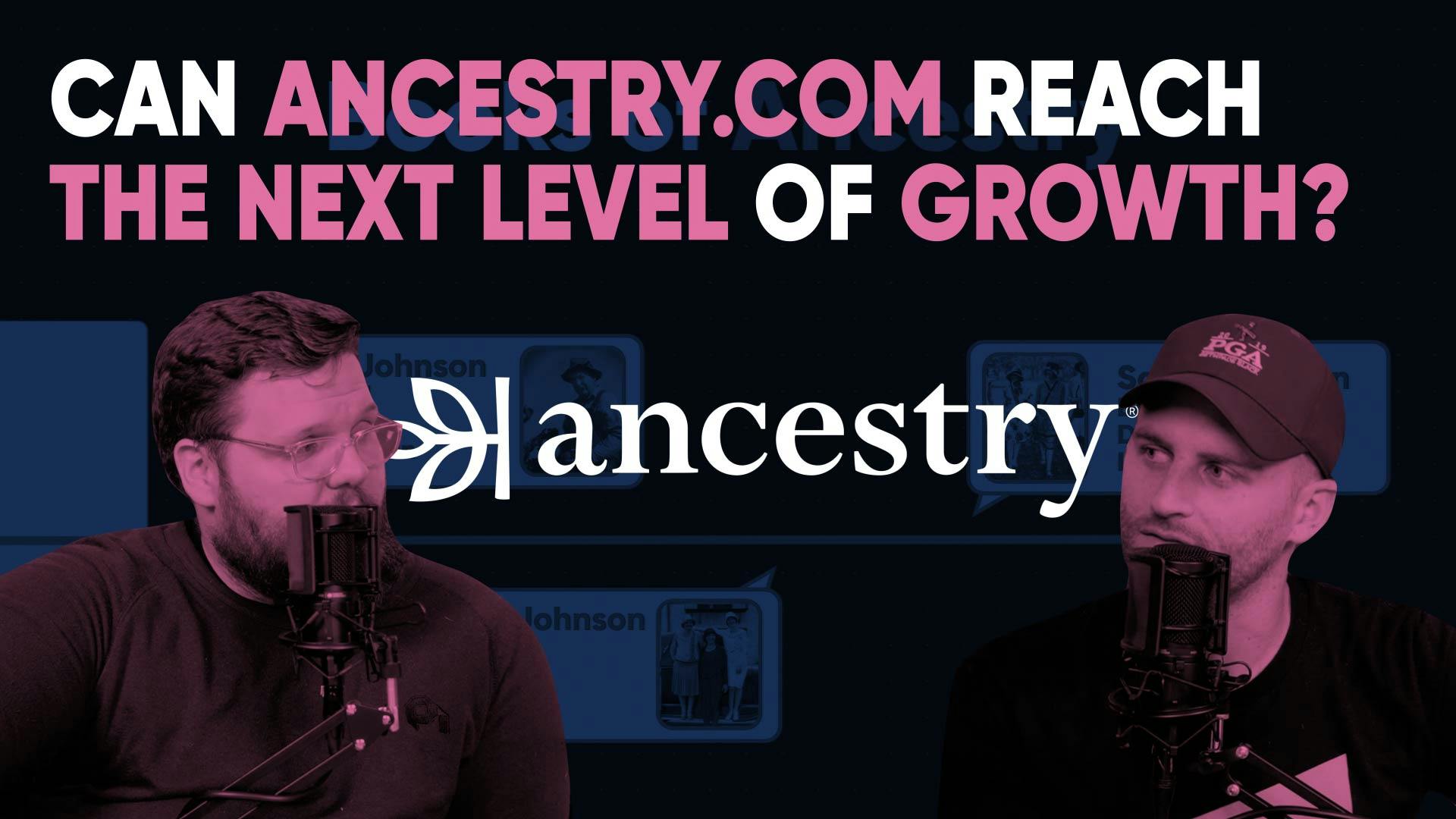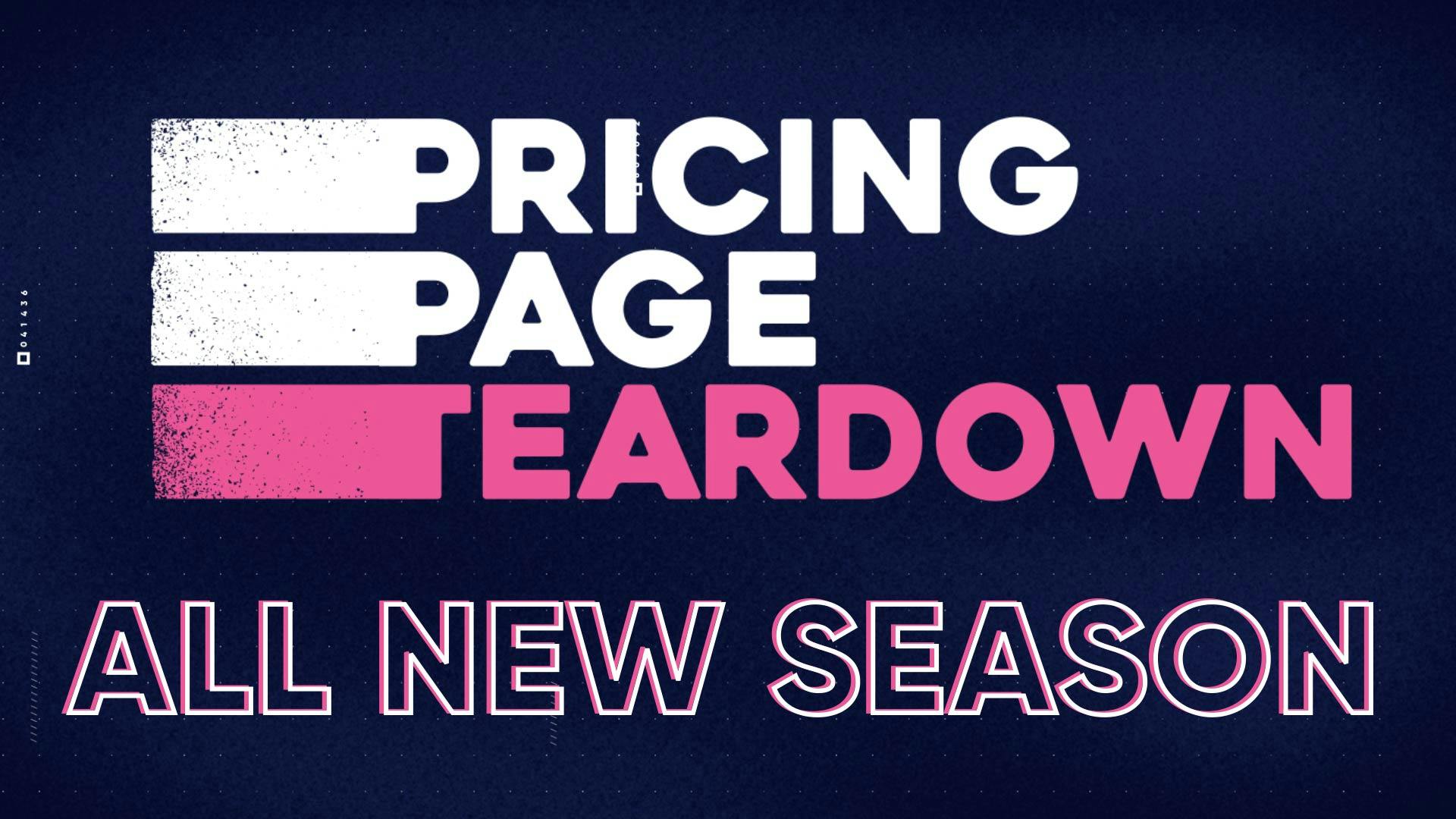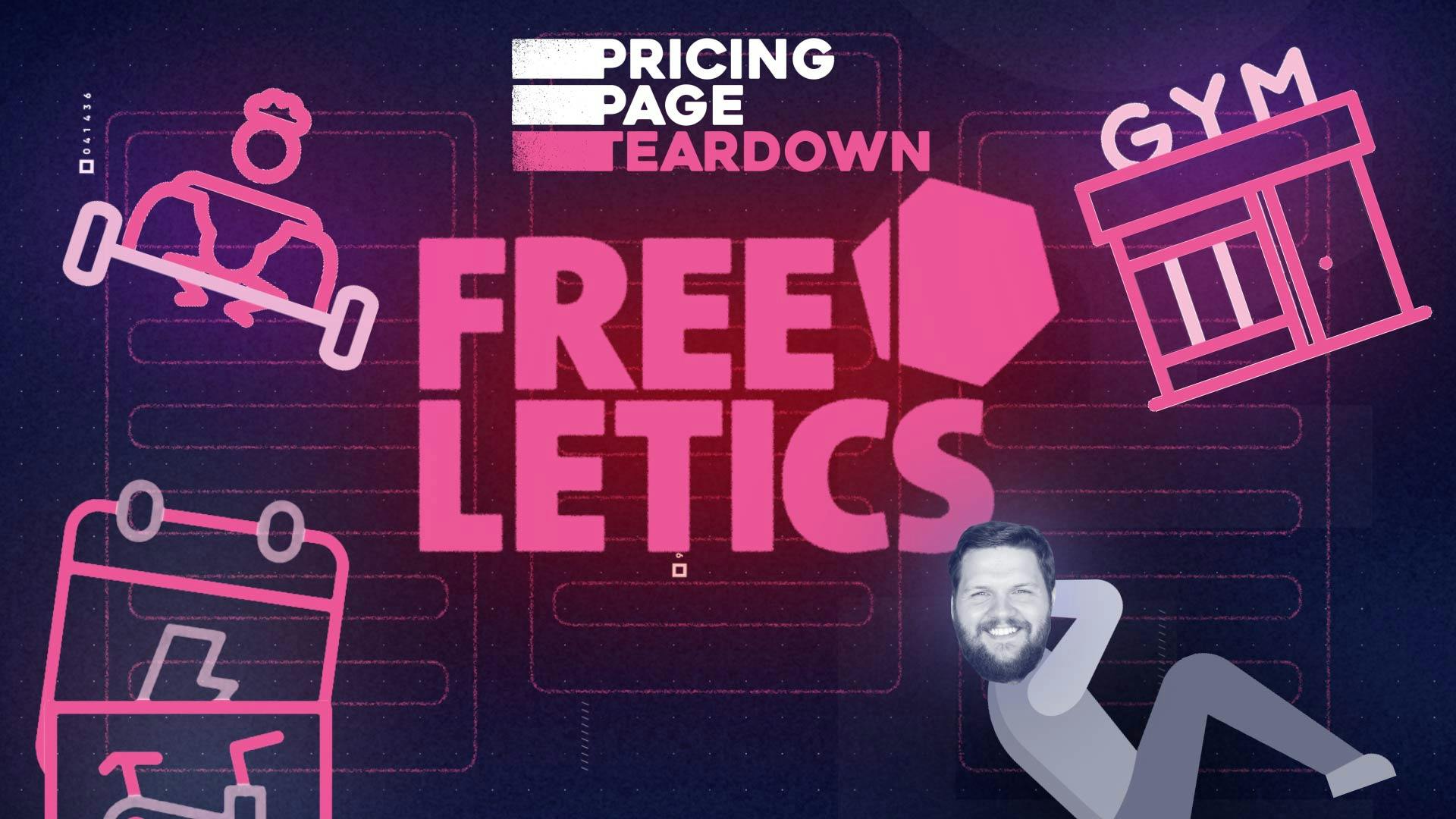
Should Chipotle have a subscription?
This episode might reference ProfitWell and ProfitWell Recur, which following the acquisition by Paddle is now Paddle Studios. Some information may be out of date.
Please message us at studios@paddle.com if you have any questions or comments!
Chipotle
Chipotle started as a quick-service Mexican restaurant next to the University of Denver, serving San Francisco style burritos. The founder, Steve Ells, calculated that he needed to sell 107 burritos per day to make a profit. However, within the first month, Chipotle was selling over 1,000 burritos per day. This led to the abandonment of Ells' original fine dining restaurant plan. Chipotle now has over 2,500 locations in the US, Canada, and Western Europe, with an annual revenue of $5.6 billion dollars.
Chipotle's success is based on controlling the product. All of Chipotle's ingredients are locally grown and freshly made every day. There are only 53 ingredients offered by Chipotle, but they allow for quality control. Chipotle automated as much as possible to increase efficiency and added digital ordering and a second assembly line to reduce wait times. Chipotle charges accordingly for their quality, with an average order value of $15, three times that of McDonald's.
Control of product and their thesis was great for Chipotle, but it may have caused their downfall, because their growth was as fragile as a piece of lettuce. Turns out they didn't have control over the execution of that vision. Chipotle reached an all-time high in 2015, with a stock price of over $700 per share. However, six different food-related illness crises within six months caused a rapid decline in the company's reputation. These crises broke the trust in the company's "food with integrity" thesis.
Chipotle's making a comeback though, and thankfully the products are good, they just need to get better at executing at scale. They started with naming a new CEO in March of 2018—Brian Niccol, the former CEO of Taco Bell, who has experience playing the execution game.
Yet, there's more to be done. And while Chipotle isn't far into their comeback—the stock is at an all time high. There are some clever things Chipotle could do to rise to Starbucks' or McDonald's level while still maintaining the "food with integrity" thesis. They involve some pretty big changes though. Keep reading.
Data and analysis
Unlimited memberships and tiers only work if the amount covers LTV and/or buys into superfans
Unlimited memberships and tiers are great concepts that can cover the lifetime value of customers and attract super fans. For physical goods like Chipotle, unlimited plans can be used for marketing purposes to cover costs and lifetime value. For B2B, I suggest putting an unlimited lifetime plan in place for a higher price than the current lifetime value to increase earnings potential over time without capping growth.
When is an unlimited monthly subscription to Chipotle too expensive? We analyzed brand affinity data from people who dislike, are neutral towards, and are superfans of Chipotle. Superfans are willing to pay a median of $350 monthly, which is equivalent to 30 burritos per month or one per day. However, not everyone will use it daily, and the subscription can cost over $500 per month.
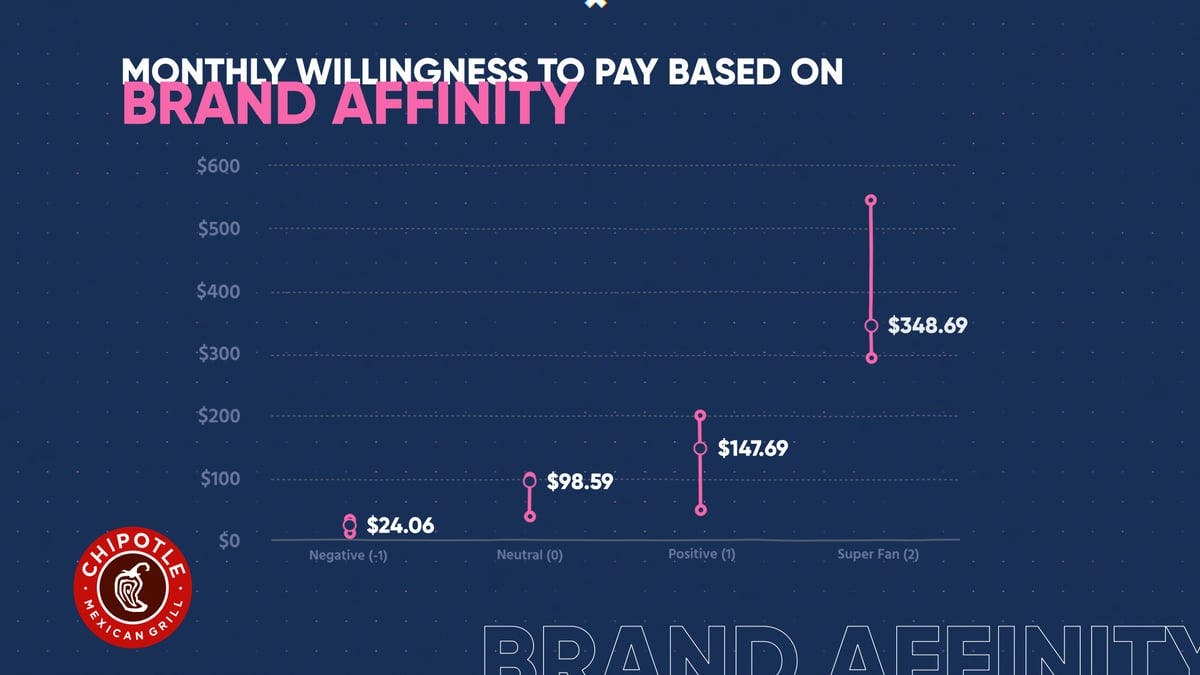
If you're a Chipotle fanatic, just search Chipotle on Twitter. Celebrities like David Dobrick and Scott Galloway talk about it all the time. Those who go daily are willing to pay a median price of $500. Even those who go multiple times a week are willing to pay up to $250. An unlimited membership or subscription with added perks could be a great opportunity. If just 10% of their base buys into it, they could make a profit with monthly payments of $350 or even $500.
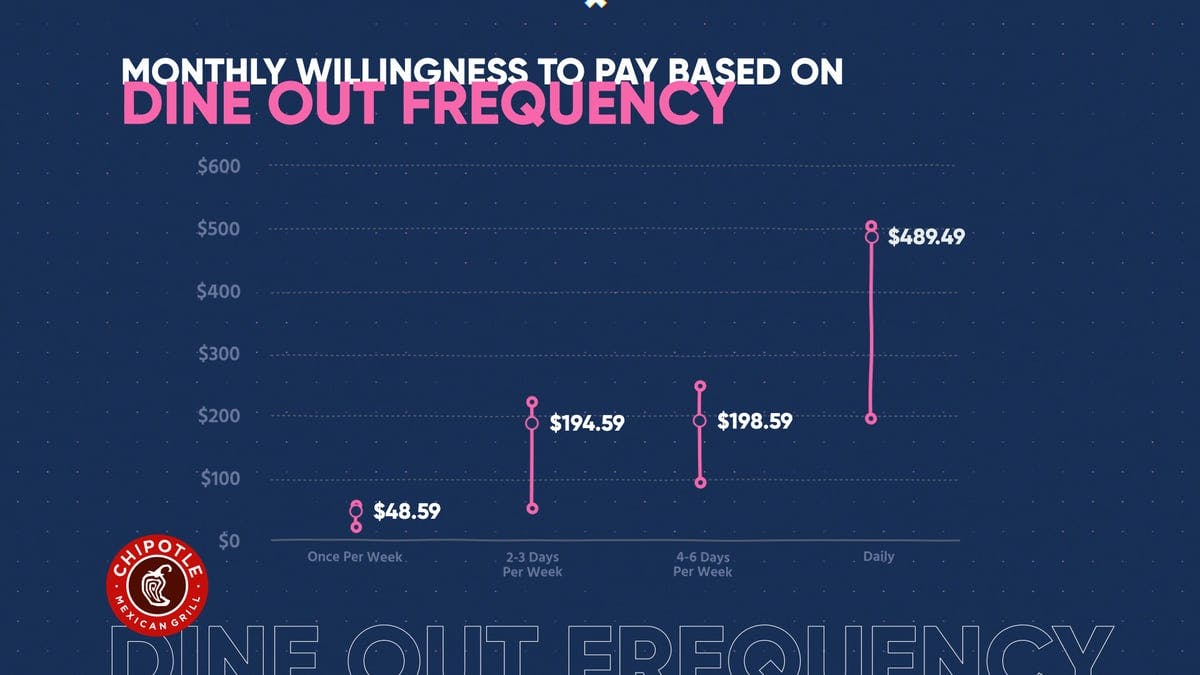
Value Matrix
You're about to see something called a value matrix. We collected data from the group comparing feature preferences and plotted those on the horizontal axis, more valued features on the right, less valued on the left. We then collected willingness to pay for the overall product and plotted that based on their number-one feature preference on the y-axis. Analyzing data in this manner allows us to determine which features are differentiable add-ons, core, or commoditized for each segment.
Tax the reduction in your number-one, unavoidable pain.
To reduce your main pain point, consider taxing it. The biggest issue with places like Chipotle and Sweetgreen is the long lines. Our value matrix shows that prioritizing a line-skipping feature is highly preferred and has a high willingness to pay among those who care about it.
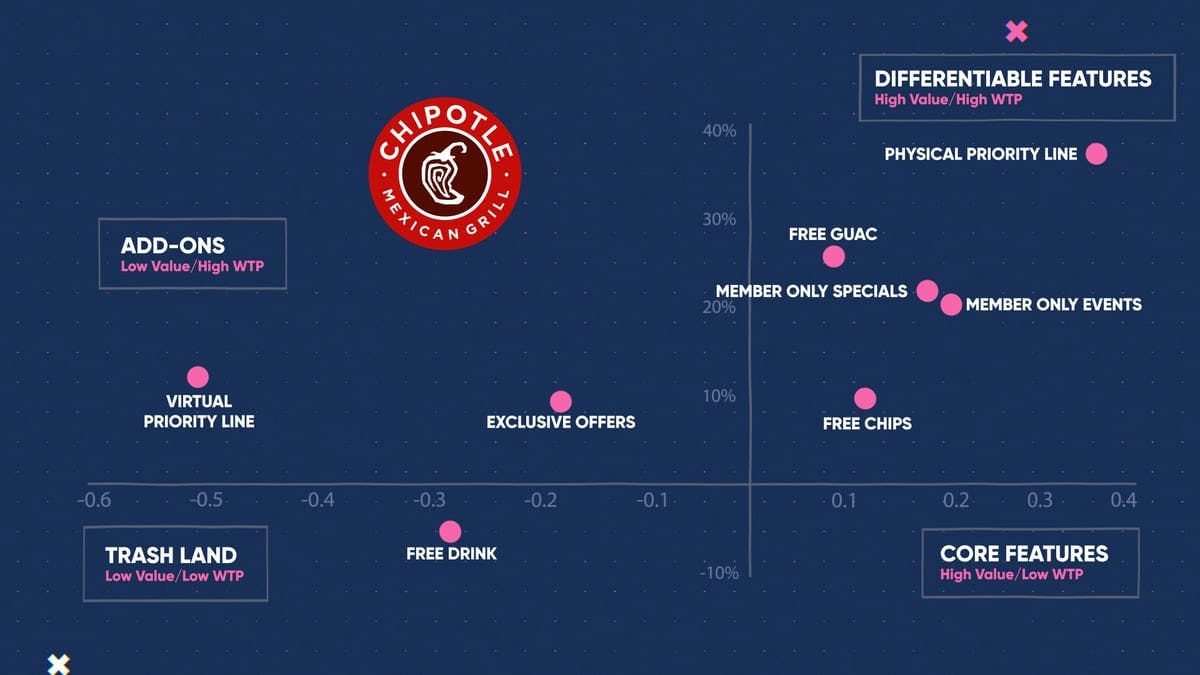
Member-only events and specials can be even more interesting. Subscription-based relationships can generate more revenue, as customers who purchase an unlimited card often share their experiences on social media. Hosting member-only events can increase customer acquisition costs, lifetime value, and average order value. Offering free items like guacamole, chips, or drinks may not be as effective as utilizing this group of customers who are willing to pay more.
You become part of your customer's identity
Finally, you become part of your customer's identity. We mentioned this a little bit earlier, but if Chipotle released this, they would have customers going viral. They'd be tweeting about it, they'd be spreading the word like crazy. These exclusive member events and being able to cut the line, this stuff would spread like wildfire.
The biggest misconception about subscription models, especially when attached to physical-good businesses, is the assumption that everyone needs to use it. Apple has over 800 million, if not a billion, credit cards on file. They do not require every single person to use a recurring revenue bundle. Similarly, Chipotle does not need every customer to subscribe at $350 to $500 per month. By targeting a small group of people, you can generate a $100-million revenue stream from existing customers. By offering a subscription, you can strengthen the relationship and encourage reciprocity. This is a powerful strategy.
Focus on your absolute super fans and cater to their needs. Nurture these fans by incentivizing them to give you more money or bring in more customers. Don't just rely on having millions of fans like Chipotle; the "thousand true fans" principle still applies. Remember that features are no longer the key differentiator - they are simply expected. The real value is in building a strong identity and relationship with your customers.
In conclusion, Chipotle's success story is one of control and quality of product. However, the company's downfall due to food-related illness crises has brought to light the need for better execution at scale. The company's new CEO and potential implementation of unlimited memberships and exclusive member events could help Chipotle rise to the level of fast food giants like McDonald's and Starbucks, while still maintaining their "food with integrity" thesis. By focusing on their super fans and building a strong relationship with them, Chipotle can generate a sustainable revenue stream and strengthen their brand identity in the competitive fast food market.
Need help with subscription pricing?
Price Intelligently by Paddle is revolutionizing how SaaS and subscription companies price and package their products. Founded in 2012, we believe in value-based pricing rooted in first-party research to inform your monetization strategies. We combine expertise and data to solve your unique pricing challenges and catapult growth.
(00:00):
You can't associate your brand with health and then have seven different giant health scares and not make change or not expect your stock to just get completely trounced.
(00:13):
Welcome to Pricing Page Teardown where the ProfitWell Crew breaks down strategies and insights on how subscription companies from all corners of the market can win with monetization.
(00:29):
Welcome to Pricing page teardown. I'm Patrick Campbell. I'm Rob Litterst, and this week we are talking about the champion of fast casual, healthy dining. Chipotle, the champion of our hearts, the champion of our hearts. Let's be honest, we are gonna be walking through what Chipotle is doing well with their pricing strategy and implementing what we think is a really, really good idea to boost not only shareholder value, but also the value to all of their customers by instituting a membership program. It's gonna be a little controversial, but we have the data, we have the insight, and ultimately we have the right points that you can take into your business while also learning from what a giant behemoth success story has actually done within the fast casual space.
(01:15):
Most people dunno that Chipotle actually started as a means to an end founder Steve Ellis wanted to open a fine dining restaurant after training under renowned chef Jeremiah Tower. Fine Dining though is expensive, so ELs thought he could raise cash by opening a quick service Mexican restaurant right next to the University of Denver, an $85,000 loan from his father. Thanks dad. And some cost saving sheet metal decor later. The first Chipotle opened in 1993 to serve San Francisco sell burritos ELs and his father calculated that they needed to sell 107 burritos per day to make a profit and anything over that would go into the fine dining fund. Yet within the first month, Chipotle was selling over 1000 burritos per day. Based on this success, ELs abandoned the fine dining dreams, sort of as we'll find out in a bit. But 26 years later, Chipotle now has more than 2,500 locations in the us, Canada, and Western Europe, and an annual revenue of 5.6 billion per year.
(02:12):
It's not all rainbows in sofrito though, as we'll see in a bit. Chipotle was in a world of hurt the past few years. First up though, what made them so successful in what gives them potential to be successful in the future? Chipotle is the epitome of controlling the product. If you've ever watched fine dining chefs, you know they can be jerks in the kitchen about the quality of the food. ELs was no different with Chipotle. He tapped into the thesis of food with integrity and formed the ingredients to the options offered. Everything was tightly controlled. All of Chipotle's ingredients are locally grown, including the 100,000 avocados used every day for the guacamole, and they're one to one and a half pound burritos. Those ingredients are freshly made every day, and while there are 60,000 different types of burritos you could order, there are only 50 ingredients used by Chipotle.
(03:00):
Control allows for quality. This is insane when you're thinking about most quick service restaurants because in a restaurant you have two main ax axis of growth. You can serve more customers or you can increase the amount of money each customer spends with you by selling them more Chipotle rebuffed analysts by not offering more options, opening stores for breakfast or even franchising to scale quicker, even though this would lead to billions more in sales. Instead, Chipotle kept the constraint of food with integrity and did everything they could to maximize these two axes of growth to get more butts in seats. They learned from their competitor McDonald's and automated as much as humanly possible. As anyone who's been through a lunch rush Chipotle line can attest those employees are fast, even at the speed in which they ask if you want gac, which is extra. Of course.
(03:47):
More recently they've added digital ordering and a second assembly line in the back for no line pickups and even drive-through pickups to increase order size. Chipotle's been unapologetic about their quality and charges accordingly. The average order value is right around $15, which is three times Z of McDonald's. Even though McDonald's offers almost 10 times the number of options including breakfast all day, and a store that's open 24 hours per day, turns out quack chips and a beverage is all you need to take on the happy clown control of products. And their thesis was great for Chipotle, but it may have cost their downfall because their growth was as fragile as a piece of lettuce. Turns out they didn't have control over the execution of that vision. Starting in 2015, Chipotle was at an all-time high with a stock price of over $700 per share, but it all came tumbling down when they experienced not one but six different food related illness crises in less than six months.
(04:41):
July, 2015, e coli outbreak in Oregon, August, 2015, norovirus outbreak in California. Also August, 2015, salmonella outbreak in Minnesota. October, 2015 e coli outbreak in Washington and Oregon. November, 2015, e coli outbreak in Kansas and Oklahoma. And then December, 2015, norovirus outbreak in Boston. They broke the trust and the thesis they used to succeed. Food with integrity doesn't end up making people sick. When you walk into a McDonald's, you're not expecting high quality ingredients. You're expecting consistency and speed. We don't wanna get sick from a McDonald's hamburger either, but we know we're not making a healthy decision for Chipotle even though their burritos can top 1000 calories. Health is everything. And while we should appreciate that there are nuances when using fresh lettuce and tomatoes in a sea of options for fast casual dining that rose in the wake of Chipotle, why wouldn't we just go to Sweet Green Panera Culvers or the multitude of upstarts popping up in cities across the states?
(05:41):
Sure the diehard stayed, but a brand can't grow without the casual diner. Chipotle is making a comeback though, and thankfully the product is good. They just need to get better at execution at scale and they started with naming a new CEO in March of 2018. Brian Nichol, the former CEO of Taco Bell, who has experienced playing the execution game yet there's more to be done and while Chipotle isn't far into their comeback, the stock is at an all time high and there are some clever things Chipotle can do to rise to the level of Starbucks or McDonald's while still maintaining the food with integrity thesis. So we're gonna answer this question by collecting data from Chipotle customers and get to the bottom of how Chipotle can increase their value.
(06:24):
Did the healthcare stuff ever impact
(06:28):
Desire to Yeah. Each Chipotle? Yeah. I mean I was probably thrown off Chipotle for maybe like a month,
(06:34):
But I also think that like, I don't think of enough people appreciate having healthy food. The bar for safety and stuff is so much harder. I think that that's where Chipotle got into trouble. Oh yeah. Because if you look at the stock price, like we talked about in the background section, you know, they associated their brand with health and wellness and clean and organic. I think what's really fascinating is this point about execution of mission needs to go through with execution of like production with a guy who ran Taco Bell, you know, which is basically an execution machine given how cheap it is taking over Chipotle, I think it's just a win-win situation as long as he doesn't tinker with the thing that got them there,
(07:14):
Just bring them back to that healthy, fast casual vibe and they're good.
(07:18):
Absolutely. Well, we're gonna do something a little bit different today. We're gonna talk about a hypothetical subscription for Chipotle and it's an unlimited subscription. So what we did is we went out into the market, we talked to current Chipotle customers, prospective Chipotle customers, and basically wanted to figure out what was the viability of a subscription and what was the viability of an actual, you know, membership model to Chipotle. And the way we're gonna kind of walk through this to make sure that there's really, really good lessons for you is we're going to essentially talk about how you can collect this data yourself to look at the viability of your own subscriptions or your own pricing strategy and make sure that you can test things before you obviously implement. Because a multi-billion dollar company like Chipotle isn't just going to willy-nilly throw a subscription out there. Um, although they probably should based on should based on the data that we're about to get into. Yeah, you wanna get into it? Ready to roll? Let's jump in. All right, cool.
(08:11):
So where does our data come from here at Profit? Well, our Price Intelligently products combines proprietary algorithms and methodologies with a team of pricing experts who think about this stuff more than anyone else to help companies optimize their monetization strategy. We do this by going out into the market and collecting data from current and prospective customers. Having the ability to collect data from everyone from a soccer mom or dad in the middle of Kansas all the way to a Fortune 500 CIO in South Africa. We then take that data and run it through our algorithms and analyze it in every direction to determine a company's ideal customer profiles, as well as which segments value which features and which segments are willing to pay more. All in the spirit of determining how a company can use monetization for growth.
(09:00):
First up, let's talk about this concept of unlimited and this whole concept that unlimited memberships and tiers are actually really great if the amount of the unlimited price covers your lifetime value and or buys you into your super fans, right? If I see an unlimited plan that's just kind of willy-nilly thrown onto a pricing page, I I'm like, this is terrible, don't do this, et cetera, because you're kind of capping your growth, right? Yeah. But when you're dealing with like a physical good, like something like Chipotle, what ends up happening is, is you can actually use it from a marketing perspective to cover of the costs or to cover the actual, you know, lifetime value of that customer. So to give this into a B2B sense, what I'll tell some people um, is I'll say, Hey, what's your current lifetime value? And if they're like, oh, it's $150 for a consumer product, I'll say, great, put an unlimited lifetime planet $200.
(09:52):
Yeah. And they're like, well wait a minute, isn't that gonna like hurt, you know, my, my earning potential in the future? And it's like, no, because your lifetime value is $150, right? And theoretically you're going to improve that over time, but you can always sell that to sell something else to those people. New add-ons. New add-ons, or you can boost the unlimited lifetime plan on future users as well. At what point would an unlimited subscription to Chipotle a monthly be way too expensive? I feel like a hundred bucks. Like that's probably, that's too expensive. That's, that's like too expensive for me. Like that's my upper limit. Sure. What's a good deal? You would like sign up today if I had unlimited Chipotle for like 50 bucks a month, ship it. Okay. Because here's what's really, really fascinating. When we looked at this data, oh my goodness.
(10:32):
And we looked at it based on brand affinity, people who were kind of like negative, like they didn't like Chipotle, we still wanted to get their information. People are kind of neutral and we really care about the super fans here because the willingness to pay, at least when we just look at the superfans, the median is about 350 bucks a month, right? Yeah. And if you think about the average, you know, kind of Chipotle order is about $14, right? And an average burrito is about 10. You're talking about like 30 burritos in a month, which is basically one a day, right? Yeah. But not everyone's gonna use it every single day. Right. The other thing to kind of think about is look at the range. Look how high that it goes So high. Yeah. We're going over $500 a month. It's almost 600 for Chipotle subscription.
(11:09):
Yeah. If Chipotle is part of your identity, and I know that sounds ridiculous to some people. Yeah. But just search Chipotle on Twitter. David Do Brick has been a big influencer. Scott Galloway talks about Chipotle Oh on your podcast all the time. But the other thing that's really, really kind of fascinating is when we look at based on frequency, those people who go daily, they're median willingness to pay jumps to about $500. So all of a sudden you're way over the average order value for basically once a day. Right? Right. It's not about a discount, it's about some perks that can be added to this. Those folks who are going a lot of times a week, you're still looking at about 200, $250 a month. Yeah. And when you're doing with an unlimited membership or unlimited subscription or a lifetime value, you're not trying to get everyone, they get 10% of their base to buy into this recurring revenue bundle. All of a sudden they're living in a world where their valuation is going insane. Oh yeah. We're gonna see a Domino's phenomenon where all of a sudden Chipotle's gonna be worth, well higher than most tech companies. I don't see a world where they're not making margin on these subscribers. No way. Especially if they're at 500 bucks a month even I would say at 350 bucks a month. Exactly. It's such a win. But I think the other thing to really think about is that you want to tax the reduction in your number one unavoidable pain.
(12:21):
You're about to see something called a value matrix here. We collected data from the group comparing feature preferences and plotted those on the horizontal axis. More valued features on the right, less valued on the left. We then collected willingness to pay for the overall product and plotted that base on their number one feature preference on the y-axis. Analyzing data in this manner allows us to determine which features are differential add-ons, core or commoditize for each segment.
(12:50):
What's the number one problem with Chipotle or Sweet Green or any of these other products? Oh, the lines. The lines. And what we found when we looked at the value matrix here is that this physical priority line, basically making sure you can skip the line, had really, really high affinity. Meaning it was preferred over the other features and it had really, really high willingness to paper people cared about it. Yeah. But even more interesting member only events, member only specials, the beauty of a subscription is the relationship is baked into how you make money. These are the folks who got their unlimited card, they're gonna tweet about it, they're gonna tweet when they get Chipotle. Oh definitely. They're not only gonna help increase the margin, you throw 'em some member only events and all of a sudden what starts happening is you actually get more CAC implications, more lifetime value implications, more average order value implications.
(13:39):
And you don't even need to give them the free guac or the free chips. No. Or even the free drink that are on here because those aren't necessarily the highest things on the list. People don't understand that they have a group of people in their customer base that's willing to pay more. Finally, you become part of your customer's identity. You mentioned this a little bit earlier, but if, if Chipotle released this, they would have customers going viral, they'd be tweeting about it. Yeah. They'd be spreading the word like crazy. These exclusive member events being able to cut the line, this stuff would spread like wildfire. The biggest misconception about a subscription model, especially when you're attaching it on top of a physical good business is that everyone needs to use it. Apple's got 800 million credit cards, a billion credit cards probably at this point. Cuz that data's from 2018.
(14:23):
They don't need to have every single person using a recurring revenue bundle. Right. Like Chipotle doesn't need everyone to use this, especially at 350 to $500 per month. No. Like you have a a small group of people and all of a sudden you're looking at a hundred million dollar revenue stream for people who are already coming to you. Yeah. You're just giving more into the relationship. Get a little reciprocity Yeah. Of them actually buying a subscription. And I think it's a really, really powerful thing to do. We talk about this principle all the time with
(14:50):
The thousand true fans and it's like just because Chipotle has millions and millions of fans doesn't mean they can apply that same strategy. Like absolutely find your absolute super fans and give them what they want.
(15:00):
Find a way to nurture those fans, help them give you more money or at least help them get you more customers. And I think that's a really, really big thing that not enough people are thinking about. The features are not the thing anymore. Those are table
(15:11):
Stakes. The relationship
(15:12):
Now it's like part of the identity, part of the
(15:13):
Relationship. Exactly.
(15:17):
Let's recap.
(15:18):
First up, unlimited memberships and tears only work if the amount covers the LTV and or buys into super fans.
(15:26):
Totally. Don't be afraid to do an unlimited plan, just make sure it covers your LTV and then some. You're not gonna get a hundred percent of people, but that's totally fine. Yeah. Um, Headspace does this really, really well. Calm does this really, really well. Exactly. There's some real estate products that do this really well. Next up, make sure you're taxing the reduction in your number one avoidable pain in B2B businesses. This is a little bit hard. It might be time it takes to do something. It might be support, it could be a whole host of things. You gotta make sure to careful balance the retention and revenue implications. But in a world where there's a physical line that is the easiest thing to tax. And yes, you can still have mobile ordering and ghost kitchens to basically expand your capabilities, but make sure you're also providing those folks who are more than willing to pay to skip the line. The ability to skip the line fast pass. One of the biggest innovations in the world of theme parks. Ah, we should be using this in some way, even if it's a little bit artificially created in the world of software. Yes. In the world of other types of subscriptions.
(16:23):
Totally. Finally, you become part of your customer's identities. Take advantage of it.
(16:28):
Hundred percent.
(16:28):
Chipotle has super fans. This is something that they should absolutely be doing. Yeah.
(16:32):
There's people who go every single day. Yeah. There's people who go sweet Green every single day. Yeah. There's people that, you know, these new wave brands. Clover in Boston. Yeah. Clover in Boston all the time. Yeah. Like make sure you take advantage of it. Make sure you have those super fans and make sure you accelerate them. And don't think such short term, don't think so transactional. Think about that relationship because ultimately that's what business is all about.
(16:54):
Well that's all for this week's episode of pricing page. Teardown. If you got value from this, if you enjoyed it, if you had a little bit of a chuckle or you wrote something down to take into your business, please, please, please share this on the social media channel of your choice. Twitter, LinkedIn, Facebook, whatever you're using. We want to get this knowledge, we want to get this evangelism in the hands of as many practitioners and operators as possible. And if you're not subscribed already, go to pricing page teardown.com and make sure you sign up. And if you want help with your business in terms of monetization strategy, getting some data to help you consider your next subscription, your add-on strategy, your packaging, or everything in between, feel free to email me@patrickprofitwell.com or email rob profitwell.com and we'll get you hooked up with all the answers to your questions, all the data you need and all the software you need as well.
(17:39):
Who do we have next week? Pc
(17:41):
Next week we have an accounting behemoth. Ooh. That actually went public I'm pretty sure in the first month of existence. Really? Yeah. It was not a good reason why that happened. Wow. Um, it was basically so that they could raise money. Awesome. Um, out of New Zealand. Okay. So a Kiwi based company, um, it's zero zero counting and it's one of the, one of the first examples of a financial or a functional product in the world of SAS and subscriptions that actually was able to take advantage of really, really good design and really, really good branding to attract people away from Intuit and away from QuickBooks, which was the huge juggernaut within the market before zero. Nice. So it's gonna be a great episode. We're gonna find out what they're doing really, really well and just what the impact of brand and design actually is unwillingness to pay. And we're also gonna find out what they're doing a little bit too poorly and where they're leaving money on the table. So you can use this as a case study for your own businesses monetization strategy. We'll see you next week.
